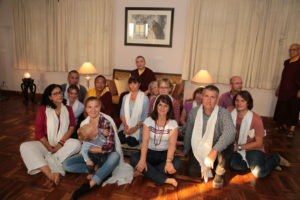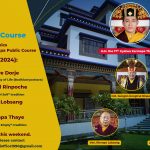The 17 Gyalwa Karmapa’s Talk on Practicing Compassion and Understanding Impermanence
October 26, 2016

I hope you all had a good pilgrimage. ‘Good’ meaning a journey with positive and moving experiences that will change your perspective on how you have lived your life so far; how we have been used to seeing things in different ways, which have defined who we have been so far; whether we have been a Buddhist or not; whether we are a beginner on the path or not.
When you operate on a different schedule, a simple trip can change even the most mundane things, from getting up in the morning, to brushing your teeth and all the other similar things you do in a day. Through almost identical routines, you saw, gained and understood something; maybe nothing grand, but at least something, which somehow changes the way you look and perceive things. It will make sense in a way that whatever will come, whatever you will see, hear and feel in the time to come, no matter how many or how few experiences there may be – somehow you will be able to go through them with less doubt, with less anxiety, with less fear. That is what I mean when I say it will ‘make sense.’ It is something productive. This is what I hope happened for you.
And if you feel like it did not happen, you do not have to be disappointed and feel that ‘it looks like some people experienced this, but I didn’t.’ Please don’t feel excluded, because that same experience, that same productivity, can be gained right here, right now. We do not necessarily have to take a journey, because we can gain it anywhere. If we can think in this way – whether we actually have a physical journey or not – it will be productive, it will make sense.
All of this is not solely related to the practice or philosophy of Buddhism. However, to connect it with the actual practice of the Buddha Dharma we need to absorb and make sense of the fact that everything is in flux. This awareness of change is the productivity that we are supposed to gain, whether we are on a physical or mental journey. We have to come to understand that everything is change.
Everything is, in fact, truly impermanent. In some way, at least, we saw it; we might not be able to pinpoint exactly how we saw it, but we got a sense and a taste of it, which is the main thing.
That is why I think the teaching of the Buddha, when he says ‘all compounded phenomena are impermanent,’ is relevant when we recite Refuge; when we practice our breathing meditation or exercise; when we practice Chenrezig; or when we help someone by offering them a glass of water or a helping hand. It can cover all angles, all aspects of life, whether we practice or do something as simple as brushing our teeth, which we usually view as a repetitive daily process or habit. However, these too are something meaningful, because they all have the potential to lead us to the recognition that ‘everything is change, everything is impermanent.’ All compounded things, in this case means everything within samsara and everything within nirvana. Samsaric things are mostly the things that we have known so far; nirvanic things refer to the practice of Chenrezig, compassion, wisdom, meditation, and so on.
To be more specific, as practitioners – whether we are studying or whether we are practicing the philosophy of Buddhism – we have to connect to this basic truth. A more traditional way of saying it is listening, contemplation, and meditation, which is known in Tibetan as tösamgom sum [Wylie. thosbsamsgomgsum]. Somehow, we have to find a way for these three processes to intimately blend with the understanding and the acceptance of impermanence. When we do this, our practices will mean something. Otherwise, we will not really be able to connect the understanding of impermanence and, for example, the practice of Chenrezig.
When we practice Chenrezig, it is of course beautiful. It is soothing, calming, and it is an actual practice. But does that really connect or synchronise with the acceptance of impermanence? It is difficult to say. If we are beginners it might be difficult to connect these two, which is understandable. But even if we are more experienced, we might still find it hard to connect these two. If we still find it hard after a great deal of effort, that means that there is still something to be done, and we have to find a way to do it.
In the worst case, if we do not find a way, then it is a little bit sad. Certainly, we do not want to be sad. Therefore, we must find a way to connect or relate these two, which might be a different process for each of us. To some of us, maybe we will be able to connect the two through commontraditional methods, but some of us may need radical methods. This varies, but the point is that we have to find a way. I cannot pinpoint and say ‘you have to go about it like this!’, because it might be working for me, but it may not necessarily work for you. And what is working for you might not work for me. Otherwise, if we do not incorporate the truth of impermanence, practicing Chenrezig could just be a way to escape from everyday responsibilities and challenges. It could become a sort of ‘happy place’ for us practitioners, but nothing more than that. As a result, once we stop our practice, we are back into the everyday things again. And like this, of course, time passes by – without any real productivity.
We need to have at least an idea that we are practicing compassion, we are practicing Chenrezig. Why? Because it is the only way we will come to know, understand and accept that everything is impermanent. Then, our practice is going somewhere. Because otherwise, we will see ourselves as real, permanently existing practitioners who practice an equally real sadhana of Chenrezig, thinking of Chenrezig as a figure or an idea existing somewhere out there. We are desperately trying to glue these two together, ourselves and our imagination of Chenrezig, to make ourselves wholesome and complete. If we try to do it in this way, then I don’t think it will really work.
The way it could work is that, when we practice Chenrezig, we accept first the basic fact that, ‘I am not real. I am just compounded of many things: feelings, emotions, karma, and many other things. Of course, there is a form and an idea of me, but it is just a compounded phenomena and nothing more.’ If we can find a way to accept this, then whatever we try to connect to, we will do it with this understanding. This doesn’t mean that Chenrezig is also just a compound of emotions, feelings, and karma. However, the practice of Chenrezig is just a compounded means, and nothing more. It is nothing in absolute terms, nothing really existing or tangible. This makes it easier, somehow. It is not like the practice is ‘out there,’ and I am ‘here.’
This understanding, this basis is very suitable, so that this almost ‘imaginary’ practice can also find a way to make sense – not in the way that two things become one, but somehow we ourselves can become the practice, we ourselves can finally become Chenrezig, we ourselves can become compassion. Otherwise, there is no real base, you see. It is almost impossible. We can put anytwo objects together for a long time, but it is always divisible – it can always be subjected to separation from the moment we put these two things together.
If we can come to understand it in that way, then if we practice Chenrezig or compassion it will somehow start to make sense. Otherwise, we will look at this form not as compounded form, but as something permanent. If we look at this ‘permanent’ me or self, we see nothing but emotions and karmas from all angles, which is of course not desirable or attractive. At the same time, we look at compassion as something very attractive separate from us out there. Practicing compassion on the basis of this misunderstanding will lead us to the futile attempt to convert this seemingly permanent self into compassion. This, of course, is impossible.
Likewise, it is not as though compassion is a chemical compound that will turn metal into gold. Although such analogies exist in our practice, these are just analogies and therefore are not absolute. To accept the truth, we have to, in the first place, look at this form. Just for now, we can from time to time look at this ‘external’ compassion, for the sake that it is attractive and soothing. But we always have to keep in mind that this is not the real case.Simply to get inspired, we can look at compassion and we can look at an actual Bodhisattva, ‘out there.’ Just for that sake, we can give ourselves the satisfaction to think that there is a Chenrezig out there, somewhere in the clouds. But just for now! We always have to keep at the back of our minds that this is not the real thing. Our real goal is to look at this self, this form – no matter how unattractive it might appear. We have to find the courage, one way or another, to look at this form, and eventually come to accept it for what it actually is.
Often, the problem is that we cannot find a way to accept it. Therefore, we change the way we live. We change so many things: a new lifestyle, a new haircut. What else? A new religion, a new philosophy, new mottos. We change from drinking tea to drinking coffee; from drinking coffee to drinking tea; then avoid them altogether; and then we might go back to drinking them again. All of those are like signs, suggesting that we have not yet been able to accept impermanence. So we somehow have to find a way to accept: form is form, impermanence is impermanence, change is change. Change is not something else. So, in a way, it is very simple: we do not have to do anything elaborate or complicated. All we have to do is accept what it is.
We do not have to be sophisticated and think ‘Maybe it is not the obvious thing that we see, maybe there is something more’ or ‘Maybe this is not it, because it is too simple’.
So, we have to find a balance. The real balance is accepting change as change. The extremes we could fall into are thinking that ‘this is not it’ or thinking ‘there is something more’. Thinking either way deviates us from the truth. The truth is that change is change, impermanence is impermanence. It really is that simple.
Perhaps we could benefit from a little bit of logic, to make it more meaningful. We could follow the statement: ‘All compounded phenomena are change’ or ‘All compounded phenomena are impermanent’. However, to make it very simple, change is change and impermanence is impermanence. If we accept that, what happens is that, suddenly, this cloud of compassion, which we assumed was ‘out there’ or external to us, disappears. Without having to really focus on an external compassion, we will see compassion.
But for the time being, as I said, there is a benefit in thinking that compassion is ‘out there.’ But it is just a reminder. There is a risk that, if we go too scientific, too detached in the attempt to understand impermanence as impermanence, we could become a little bit mechanical. Therefore, we would not really find our purpose, why we want to understand that everything is change, and therefore we could lose our sense of direction, our compass.
In order not to lose the compass, for now; we allow the external idea of Chenrezig or compassion as a reminder. But what we have to know is that it is not the absolute –it is just a means, nothing more. If you can think in this way, then if you practice Chenrezig it will start to make sense. It will start to click. And then you will not feel like: ‘Oh, reading the scriptures, it is said that just to be able to scratch the surface of Buddhist philosophy, it takes 20 years, and just to scratch the surface of meditation, it takes 12 years, and I don’t have that opportunity! All I have is this practice of Chenrezig, and so therefore I am hopeless! I cannot even practice this Chenrezig properly either! It is a lost case. I am a lost cause.” Out of this kind of thinking, all kinds of unnecessary emotions will arise. Therefore, if we can practice Chenrezig differently, then we will gain all the inspiration we need. What this means is that whatever form of practice we are doing right now, it is almost on a par with the 32 years of the traditional practice one normally has to undergo.
The moment I say this, you could develop some sort of idea that, ‘if it is that simple, we can altogether forget about entering into retreat and other activities’. Somehow, we could find a way to be lazy again, and this is of course something we have to avoid. There is a reason why it is said that, just to get a philosophical understanding, 20 years are needed and, just to get a sense of what meditation is all about, 12 years are needed. This has a purpose. This has a real, logical purpose and we have to find a way to accept that as well, and not disregard it. It is because all the previous generations of ours, so far, have undergone those procedures, which have enabled us to make the best use of a single practice that we can do right now: Chenrezig. Therefore, we have to appreciate this, and see the benefit in it.
This is a very simple way of ‘putting everything in a nutshell,’ as the saying goes. There are many more things that could be said and I could overload you with all kinds of information, but this might lead you to lose direction. If you can somehow keep this in mind and repeat to yourself over and over again of what I just said, I have a strong feeling, a strong hunch, that it will be beneficial. Benefitting sentient beings is that simple – it is not as complicated as we think. It begins here, right now, with yourself. It is just like the analogy that is given in the teachings: in order to save someone from drowning, we must first make sure that we do not drown; we have to be in a position where we do not drown, we have to be able to swim. So, if the act of learning how to swim is motivated by the beneficial cause – the motivation of wanting to benefit sentient beings – that is Bodhisattva practice, that is a Bodhisattva act and Bodhisattva attitude.
Keep that in mind, and all will be well. Everything will be perfect and there will be nothing to worry about.
Question: The problem is that, when something changes to suffering, we don’t like what happens. When it changes, the emotions arise and we don’t know how to manage. How can we notice and be patient? Of course, the suffering will change again; but sometimes, it lasts for a long time. How can we make the mind patient, so it does not get emotional, and it kind of survives this stage?
Answer: What you are saying is correct. Whether we are beginners or not, that is the problem that we face all the time. The answer is contained within what I said before: acceptance. Or, if not acceptance, at least recognition – the recognition that everything is impermanent. The answer lies right there. And we do not really have to go anywhere, we do not have to make a long trip or a long journey (like Marpa Lotsawa had to do), or go through immense hardship (like Naropa or Milarepa) to find an answer. The answer is right there in either the recognition or acceptance of impermanence.
As long as we are not able to do that, then everything is real. Time is real, duration is real, change coming in the form of unpleasantness is real. Everything is real! In short, what Buddha referred to as the four stages or processes of life: birth, ageing, getting sick, and dying. For us, all of them are real, equally vivid, and almost more real than compassion, Buddha-Dharma, wisdom and enlightenment. Therefore, it becomes almost impossible to survive these. Of course, we want to survive! However, trying to find a solution in order to survive is futile and impossible. The trick is not to be ambushed by the idea of survival. The trick is to go out of that box, to go out of that frame, to zoom out and focus on how to accept impermanence, how to accept change. Only then will we find a way not just to survive, but to move beyond that. And, in a way, what that means is that we are somehow not bound anymore by that idea of the duration of that unpleasant experience. We are not bound by that law anymore. We are beyond that. And suddenly, something as simple as time is not real. All the unpleasantness that one may have experienced in the past (however many months or years) is literally gone, from that perspective. From that perspective, if you look at yesterday, and all the yesterdays, they are truly and utterly gone. They are not real. They will not have a shred of weight on us right now.
But if you think that they are real – if our thinking mode is that of survival – that is similar to saying that all the yesterdays were real, and then we carry all the weight of yesterdays. This becomes an almost impossible task. Then we really need to sedate ourselves, just to forget that ‘real’ past. So the trick is to accept that everything is change, meaning yesterday is gone. The past is past. This is what ‘accepting impermanence’ means. The answer lies there.
To convince ourselves or to be able to sell this product, we need a proof, a guarantee. If you look at all the experienced ones, actual Buddhas and Bodhisattvas, they are that very proof. But if even they are not convincing enough, then I will personally vouch that it does work, and that it does not take long. It does not take aeons, it does not take years or days even. It works right here, right now. All you have to do is truly give in to change, give in to impermanence, and give in to that truth. That’s all it takes!
That is why, I think, there are so many lines and quotes that say ‘liberation upon sight’, ‘liberation upon hearing’, ‘liberation upon thought’. These quotes are true. But, of course, the thing that is difficult for us to break through is that if you say ‘liberation upon thought’, we could already start to go the wrong way, when we assume that it is through thought, thought processes, concepts, imagination, theories and ideas, that we would obtain liberation. That is where we go wrong – right there! Therefore, it takes us aeons!
‘Liberation upon thought’ means ‘liberation upon a thought that is non-conceptual’. One could say ‘wisdom’, but that might sound too far. Basically, it is a kind of thought that is very genuine. One could say that it is a thought almost without an aim, without an object. That kind of thought occurs to us in 3 different stages in our lives. Firstly, from the moment we are born until we become ‘intelligent.’ During this stage, we experience a little bit of that reference-less, unconditioned thought. The second stage is when we experience moments of near-misses or near-accidents, and near-death experiences. And the third stage, unfortunately, is at the moment of death. It is unfortunate, actually, that these kinds of genuine thoughts can only occur during these moments, and not when we are healthy, happy, and intact. The challenge is there, in a way.
So that is why it is said ‘aeons’, but the reality is that it does not even take an hour or a minute; all it takes is some doing, right there. So all we have to do is, somehow, find a panic button!
Really! [Laughs] It is radical, it is almost crazy. But we have to find a panic button. It is really strange: we have to find some sort of fear. We have to go to the market and buy a product called ‘Fear’ or ‘Panic.’ It is almost like going to your teacher for a prescription in order to buy ‘Fear’ or ‘Panic’ at the pharmacy. After you bought it, you take it, and see if you can experience panic. It almost sounds like that!
Of course, it is not as radical as that. It is in fact much simpler: all we have to do is to experience that genuine thought of impermanence. In this case, we focus not on the general idea of impermanence, but more particularly on the impermanence of death, the experience of death, the consequences of death, the aftermath of death, and also on the mortality of one’s physical being and the mortality of one’s ideas. The more we do it, the more we will be able to experience genuine thought. And that genuine thought is the medicine which will give us the healthiest forms of panic! Then, without going unconscious or going crazy, we will consciously be able to accept impermanence for the first time, and give finally into it. That is all we need, and it works.
If we are trying to follow in the footsteps of the Bodhisattvas, we must know that when we try to panic ourselves, we have to do so with the motivation to benefit all sentient beings. Then all the rest of the steps become the Bodhisattva practice. In other words, compassion is right there. Then you will have a purpose.
It is not to say that a non-Bodhisattva path is bad; we are not trying to criticise any other yana or any other path of spiritual growth. All we are saying is that ‘I want to know the truth, which is that everything is impermanent and, at the same time, I want a direction, I want to know ‘true North’. I want to have a sense of direction, a purpose, a meaning’. And that is none other than compassion, which can be translated as ‘I want others to understand what I understand’. Then, everything is there.
Then, suddenly, you have no fear, no anxiety. You have none of the things that dominate our everyday life, that dictate our every action, our speech, and every intimate thought. Without having to be celebrated materialistically, we can experience the greatest celebration within ourselves – the same kind of ‘high’ that we experience when thousands celebrate us. Suddenly, without having material wealth, we are rich in every sense. More than life or death itself, which is the absolute power within our experience, we are finally in power.
Basically, if we try to summarise the whole of this experience that we call ‘life,’ it can be summarised into three things: power, fortune, fame. That is everything! That is our life, our samsaric aim. That is our moksha, our enlightenment. That is absolute for us. We practice, we meditate, we eat, we drink, we sleep, we brush our teeth… We do everything for the sake of power, fortune and fame. Of course, if those things were permanent and everlasting, by all means we should put all of our energy and strength in becoming a master of them. But…
So that will be all for today. Thank you.














